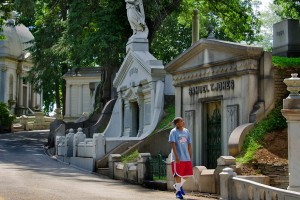George Washington Did Not Have Wooden Teeth
In American mythology, no name is as eponymous as George Washington’s—even in Philly: Washington Square and George Washington High School. Yet beyond his name or his likeness, what do people really know about the man? Philadelphians can probably discuss in great lengths the achievements or the personality of Ben Franklin and others. But what of Washington, who also lived in Philadelphia? “Discover the Real George Washington” is not just about the story of him cutting down a cherry tree or about his wooden teeth (both false, by the way). Instead, this fascinating exhibit, now showing at the National Constitution Center through September 5, reconstructs our first president and gives a glimpse into his life.
Like many other biographical exhibits, “Discover” focuses on several facets of Washington’s life: the entrepreneur, the military leader, the slave owner, and the statesman. Rooms flaunt grand displays and reproductions: a canon, his church pew. We can see a model of his home, Mt. Vernon. We learn about his part in the Revolutionary War, which has been summarized on one map—just 15 dots (cities), a brief description of what happened there, and the month and year. We see a golden locket displaying a lock of his hair.
For many the greatest section will be about Washington’s teeth. Set in a glass display and surrounded by an arc wall, sits dentures owned and warn by Washington. We learn the materials that were used to create his many dentures (human and animal teeth, lead, ivory, brass wires). And in a short video, we learn how the dentures were actually created.
But for me, it is his replicas that truly set this exhibit a part.
At the entrance, audiences can (and should) sit through a 10-minute video produced by the History Channel that explores the process of how historians and scientists created life size replicas of Washington. Unlike Madame Tussauds, which readily create models based on a living person, forensic reconstructions had to be done based on portraits, statues, and surviving clothing to create 3D, full-bodied replicas of Washington at ages 19, 45 and 57. It was a laborious and tedious process, but well worth it. These replicas, within the exhibit, emit power and humanize the mythological leader.
The exhibit does not shy away from more complicated issues. In concert with the President’s House site, “Discover” confronts the contradictory and deplorable facts of Washington, the slave owner. Though Washington did free many slaves upon his death, it is difficult to deny the fact that he owned slaves. Through displays and video interviews with experts and descendants, we learn more about the enslaved individuals owned by Washington. This topic, slavery among the Founding Fathers, is an exhibit in itself, but hopefully this brief section will instigate thought among attendees.
When the audience first enters the exhibit, they see the familiar portrait of the stark, stoic Washington painted by Gilbert Stuart. But upon exit, the complex man is no longer just an image on the dollar bill.
Follow Aaron Mettey on Twitter @AaroMets. For details on the week’s best events delivered to your inbox every Wednesday, sign up for our A&E and nightlife newsletter, The Weekender.



